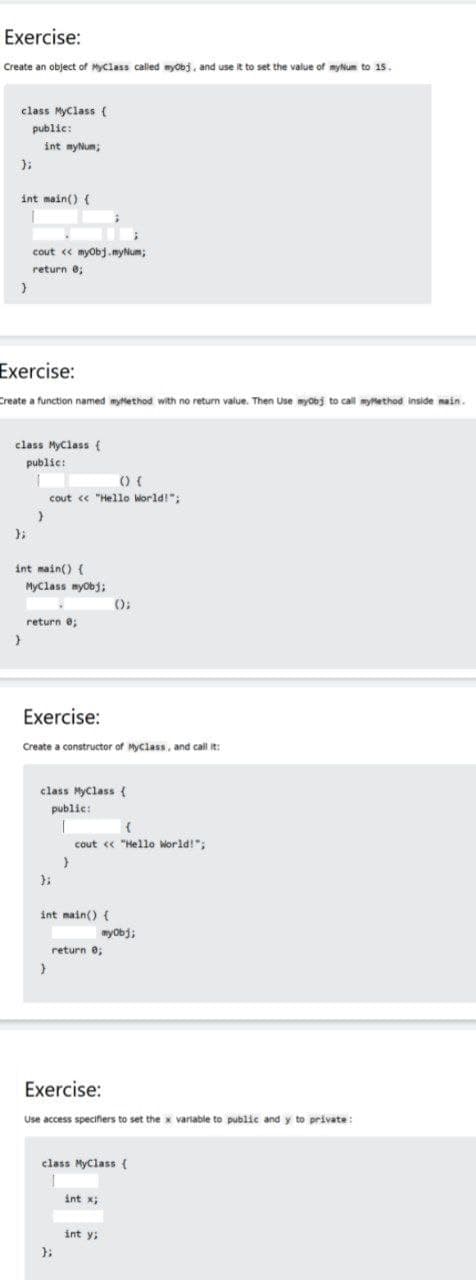Exercise: Create an object of MyClass called myobj, and use it to set the value of myum to 15. class MyClass ( public: int myNum; int main() ( cout « myobj.myNum; return e; Exercise: Create a function named myMethod with no return value. Then Use myobj to call myethod inside main. class Myclass ( public: () ( cout e "Hello World!"; int main() ( MyClass myobj; (); return e; Exercise: Create a constructor of Myclass, and call it: class MyClass ( public: cout « "Hello World!"; int main() ( myobj; return e; Exercise: Use access specifiers to set the x variable to public and y to private: class MyClass { int x; int y; }3;
Exercise: Create an object of MyClass called myobj, and use it to set the value of myum to 15. class MyClass ( public: int myNum; int main() ( cout « myobj.myNum; return e; Exercise: Create a function named myMethod with no return value. Then Use myobj to call myethod inside main. class Myclass ( public: () ( cout e "Hello World!"; int main() ( MyClass myobj; (); return e; Exercise: Create a constructor of Myclass, and call it: class MyClass ( public: cout « "Hello World!"; int main() ( myobj; return e; Exercise: Use access specifiers to set the x variable to public and y to private: class MyClass { int x; int y; }3;
Computer Networking: A Top-Down Approach (7th Edition)
7th Edition
ISBN:9780133594140
Author:James Kurose, Keith Ross
Publisher:James Kurose, Keith Ross
Chapter1: Computer Networks And The Internet
Section: Chapter Questions
Problem R1RQ: What is the difference between a host and an end system? List several different types of end...
Related questions
Question
None

Transcribed Image Text:Exercise:
Create
object of MyClass called myObj, and use it to set the value of mytium to 15.
class MyClass {
public:
int myNum;
);
int main() {
cout « myobj.myNum;
return e;
Exercise:
Create a function named myMethod with no return value. Then Use myobj to call myMethod inside main.
class Myclass (
public:
cout « "Hello World!";
int main() (
MyClass myobj;
();
return e;
Exercise:
Create a constructor of Myclass, and call it:
class Myclass {
public:
cout « "Hello World!";
int main() {
myobj;
return e;
Exercise:
Use access specifiers to set the x variable to public and y to private:
class MyClass {
int x;
int y;
};
Expert Solution
This question has been solved!
Explore an expertly crafted, step-by-step solution for a thorough understanding of key concepts.
This is a popular solution!
Trending now
This is a popular solution!
Step by step
Solved in 2 steps

Recommended textbooks for you

Computer Networking: A Top-Down Approach (7th Edi…
Computer Engineering
ISBN:
9780133594140
Author:
James Kurose, Keith Ross
Publisher:
PEARSON

Computer Organization and Design MIPS Edition, Fi…
Computer Engineering
ISBN:
9780124077263
Author:
David A. Patterson, John L. Hennessy
Publisher:
Elsevier Science

Network+ Guide to Networks (MindTap Course List)
Computer Engineering
ISBN:
9781337569330
Author:
Jill West, Tamara Dean, Jean Andrews
Publisher:
Cengage Learning

Computer Networking: A Top-Down Approach (7th Edi…
Computer Engineering
ISBN:
9780133594140
Author:
James Kurose, Keith Ross
Publisher:
PEARSON

Computer Organization and Design MIPS Edition, Fi…
Computer Engineering
ISBN:
9780124077263
Author:
David A. Patterson, John L. Hennessy
Publisher:
Elsevier Science

Network+ Guide to Networks (MindTap Course List)
Computer Engineering
ISBN:
9781337569330
Author:
Jill West, Tamara Dean, Jean Andrews
Publisher:
Cengage Learning

Concepts of Database Management
Computer Engineering
ISBN:
9781337093422
Author:
Joy L. Starks, Philip J. Pratt, Mary Z. Last
Publisher:
Cengage Learning

Prelude to Programming
Computer Engineering
ISBN:
9780133750423
Author:
VENIT, Stewart
Publisher:
Pearson Education

Sc Business Data Communications and Networking, T…
Computer Engineering
ISBN:
9781119368830
Author:
FITZGERALD
Publisher:
WILEY